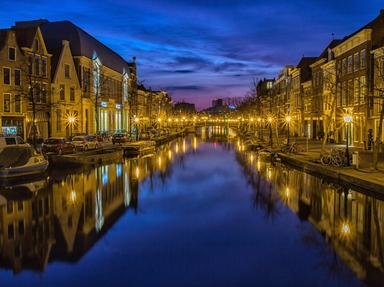Quiz Answer Key and Fun Facts
1. The Netherlands are a relatively new country. There is not much known about the country from the time prior to the Romans. Which of these cities was called "Ultra Traiectum" in Roman time?
2. In 1588, the Dutch claimed independence during the 80-year war. Which country occupied The Netherlands and was the adversary of the Dutch from 1568 to 1648?
3. The independence of The Netherlands changed Dutch life. Despite the small population (app. 2.5 million in those days), the country was recognized as an important economy and force. This era is often referred to as the Golden Century (17th century). An important key factor in its success, was the forming of the VOC, or "Vereenigde Oostindische Compagnie" (Dutch East India Company). What was NOT unique about this company?
4. The decline of The Netherlands was truly visible when Napoleon invaded The Netherlands in 1806, creating the Kingdom of Holland. His brother ruled from 1806 to 1810. Napoleon ended this in 1810 and The Netherlands became a part of France until 1813 when Napoleon's empire collapsed. Despite the relative short period of seven years, Napoleonic influence is still recognizable in The Netherlands. Which of these measures is NOT one of Napoleon's?
5. The modern Netherlands were formed in 1830. Which event marked the beginning of today's Netherlands in geographical terms?
6. On which side were The Netherlands during World War I?
7. Which city was being bombed in World War II by Nazi Germany?
8. The Netherlands are a constitutional monarchy. The formal head of state is the Queen. The Queen lives in The Hague. The parliament and cabinet are also settled in The Hague. Nevertheless, the capital of The Netherlands is Amsterdam, making it one of the few countries in the world which official capital is not the administrative capital. Why is Amsterdam still the capital of the Netherlands?
9. What are the three main religions in The Netherlands?
10. Which claim about the Dutch is true?
11. The Dutch from the past were great explorers almost equaling the Spanish, Italians, British and Portuguese. Which of these explorers was NOT Dutch?
12. The Dutch painters are among the greatest artists the world has ever seen. Which of these artists was NOT Dutch?
13. The Dutch are worthy competitors in a lot of sports. The most popular sports are football/soccer, field hockey, ice skating, cycling, swimming and kick boxing. Which of these sportsmen is NOT of Dutch origin?
14. I can do science me... The Netherlands do have a huge number of famous brainiacs. The Dutch have contributed to science and literature over the years. Which of these is NOT a Dutch invention?
15. In which of these cities was the European Union formed?
Source: Author
Angelo80
This quiz was reviewed by FunTrivia editor
Nannanut before going online.
Any errors found in FunTrivia content are routinely corrected through our feedback system.

